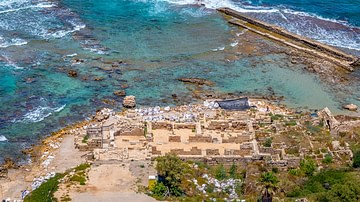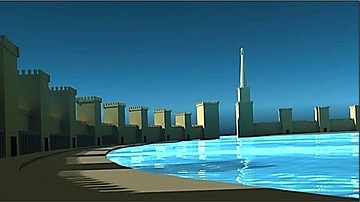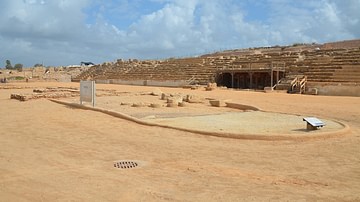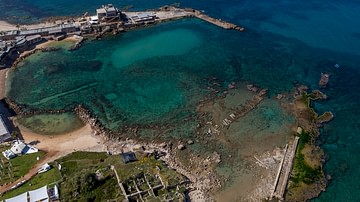Illustration
As part of Herod the Great's building program, with the temple located at the eastern foot of Herod's Harbor and the northwestern unbridgable entrance, the diameter route of its causeway would have expedited the movement of goods and military personnel. Moreover, as the causeway separated the inner harbor from the outer harbor, with the temple at its foot, the inner harbor waters were selectively plied by warships carrying dignitaries and notables.
Housing the colossi of Juno, patron goddess of Rome, and Caesar, Caesarea Maritima's temple overlooked the city's harbor. Towering nearly 30 meters (100 ft) from its Corinthian column bases to the top of its pediment and with a layout of 29 by 46 meters (95 x 150 ft), it was one of the largest temples in the East.
Using archaeological reports by Avner Raban, John Oleson, Robert Hohlfelder, and others, along with comparative analysis of known Roman construction techniques, Josephus' eyewitness descriptions, and Herodian fortification work at Jerusalem and Masada, the image you see is part of the collaborative creation of Lithodomos and Patrick Scott Smith.
About the Author
Cite This Work
APA Style
A., P. S. S. M. (2025, July 05). The Temple and Causeway at Herod's Harbor. World History Encyclopedia. Retrieved from https://www.worldhistory.org/image/20611/the-temple-and-causeway-at-herods-harbor/
Chicago Style
A., Patrick Scott Smith, M.. "The Temple and Causeway at Herod's Harbor." World History Encyclopedia. Last modified July 05, 2025. https://www.worldhistory.org/image/20611/the-temple-and-causeway-at-herods-harbor/.
MLA Style
A., Patrick Scott Smith, M.. "The Temple and Causeway at Herod's Harbor." World History Encyclopedia. World History Encyclopedia, 05 Jul 2025, https://www.worldhistory.org/image/20611/the-temple-and-causeway-at-herods-harbor/. Web. 05 Jul 2025.








